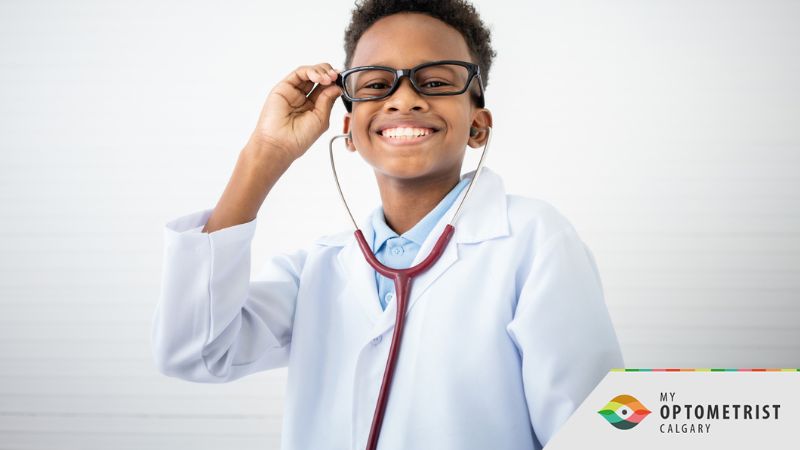
Regular eye exams are essential for detecting and managing common vision problems in children, such as myopia (nearsightedness), hyperopia (farsightedness), and amblyopia (lazy eye). At My Optometrist Calgary, early detection through comprehensive eye exams ensures timely intervention and treatment. Myopia can cause distant objects to appear blurry, while hyperopia affects close-up vision, and amblyopia leads to reduced visual acuity in one eye. Eye exams help identify these conditions early, allowing for corrective measures like glasses, contact lenses, or vision therapy. By addressing these issues promptly, eye exams support your child's vision health, academic performance, and overall quality of life. Book your child's eye exam to ensure your child's bright and clear future.
As parents, ensuring our children’s overall health and well-being is a top priority. While we often focus on their physical and emotional development, it's essential not to overlook their vision health. Children's vision is crucial for their learning, development, and daily activities. At My Optometrist Calgary, we understand the importance of early detection and treatment of vision problems. Here, we explore three common vision problems in children and how regular eye exams can help identify and address these issues, ensuring your child enjoys clear and healthy vision.
1. Myopia (Nearsightedness)
Myopia, or nearsightedness, is one of the most common vision problems in children. It occurs when the eye grows too long from front to back, causing light to focus in front of the retina instead of directly on it. This results in distant objects appearing blurry while close objects are seen clearly.
Children with myopia may struggle to see the whiteboard in school, have difficulty recognizing distant faces, or experience eye strain when trying to focus on faraway objects. Myopia typically develops during childhood and can progress as the child grows.
How Eye Exams Help
Regular eye exams are vital for early detection of myopia. During an eye exam, the optometrist will perform a series of tests to measure your child's vision and determine the extent of their nearsightedness. If myopia is diagnosed, corrective measures such as prescription glasses or contact lenses will be recommended to improve your child's vision. Additionally, the optometrist can provide guidance on myopia control strategies, such as spending more time outdoors and reducing screen time, to slow the progression of nearsightedness.
2. Hyperopia (Farsightedness)
Hyperopia, or farsightedness, is another common vision problem in children. It occurs when the eye is too short from front to back, causing light to focus behind the retina. This results in close objects appearing blurry while distant objects are seen more clearly.
Children with hyperopia may experience difficulty with tasks that require close-up focus, such as reading, writing, or using electronic devices. They might also complain of headaches, eye strain, or fatigue after engaging in near-vision activities.
How Eye Exams Help
Eye exams are crucial for identifying hyperopia early on. During the exam, the optometrist will assess your child's ability to focus on objects at different distances. If hyperopia is detected, corrective lenses, such as glasses or contact lenses, can be prescribed to help your child see clearly at all distances. Regular follow-up exams will ensure that the prescription is up to date and that your child's vision needs are being met.
3. Amblyopia (Lazy Eye)
Amblyopia, commonly known as lazy eye, is a vision development disorder where one eye does not achieve normal visual acuity, even with prescription glasses or contact lenses. It typically begins during infancy or early childhood.
Amblyopia can result from various causes, including strabismus (misaligned eyes), significant differences in refractive error between the two eyes, or a blockage that prevents light from entering the eye properly (such as cataracts). Children with amblyopia may favor one eye over the other, have poor depth perception, or experience difficulty with tasks that require good binocular vision.
How Eye Exams Help
Early detection of amblyopia is critical for effective treatment. During an eye exam, the optometrist will perform tests to assess the visual acuity of each eye and check for any signs of misalignment or refractive error. If amblyopia is diagnosed, treatment options such as patching the stronger eye, vision therapy, or corrective lenses will be recommended to strengthen the weaker eye and improve visual acuity. Consistent follow-up exams are essential to monitor progress and make necessary adjustments to the treatment plan.
Regular eye exams play a crucial role in detecting and managing common vision problems in children, such as myopia, hyperopia, and amblyopia. Early identification and treatment of these conditions can significantly impact your child's vision, learning, and overall quality of life. At My Optometrist Calgary, we are dedicated to providing comprehensive eye care for children to ensure their visual health and development. By scheduling routine eye exams, you can help safeguard your child's vision and support their growth and success. Don’t wait for symptoms to appear—proactive eye care is the key to maintaining your child's healthy vision. Contact us to schedule an eye exam for your child today and take the first step towards ensuring their bright and clear future.
FAQs
Q: What are common vision problems in children?
A: Common vision problems in children include myopia (nearsightedness), hyperopia (farsightedness), and amblyopia (lazy eye).
Q: Why are regular eye exams important for children?
A: Regular eye exams detect vision problems early, ensuring timely intervention and treatment to support healthy vision development.
Q: How often should children have eye exams?
A: Children should have eye exams at least once a year, or more frequently if recommended by their optometrist, to monitor and maintain vision health. Call one of our offices for more personalized advice.